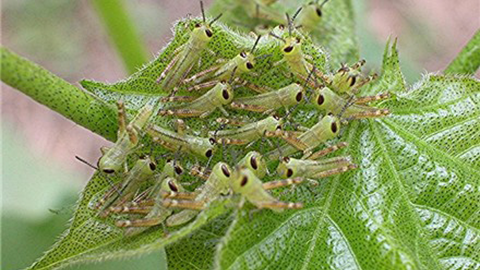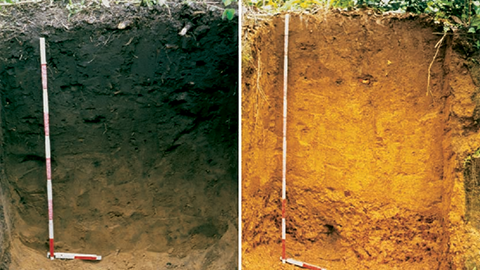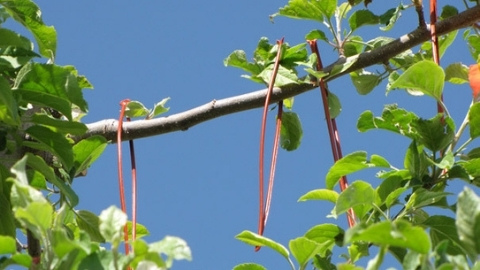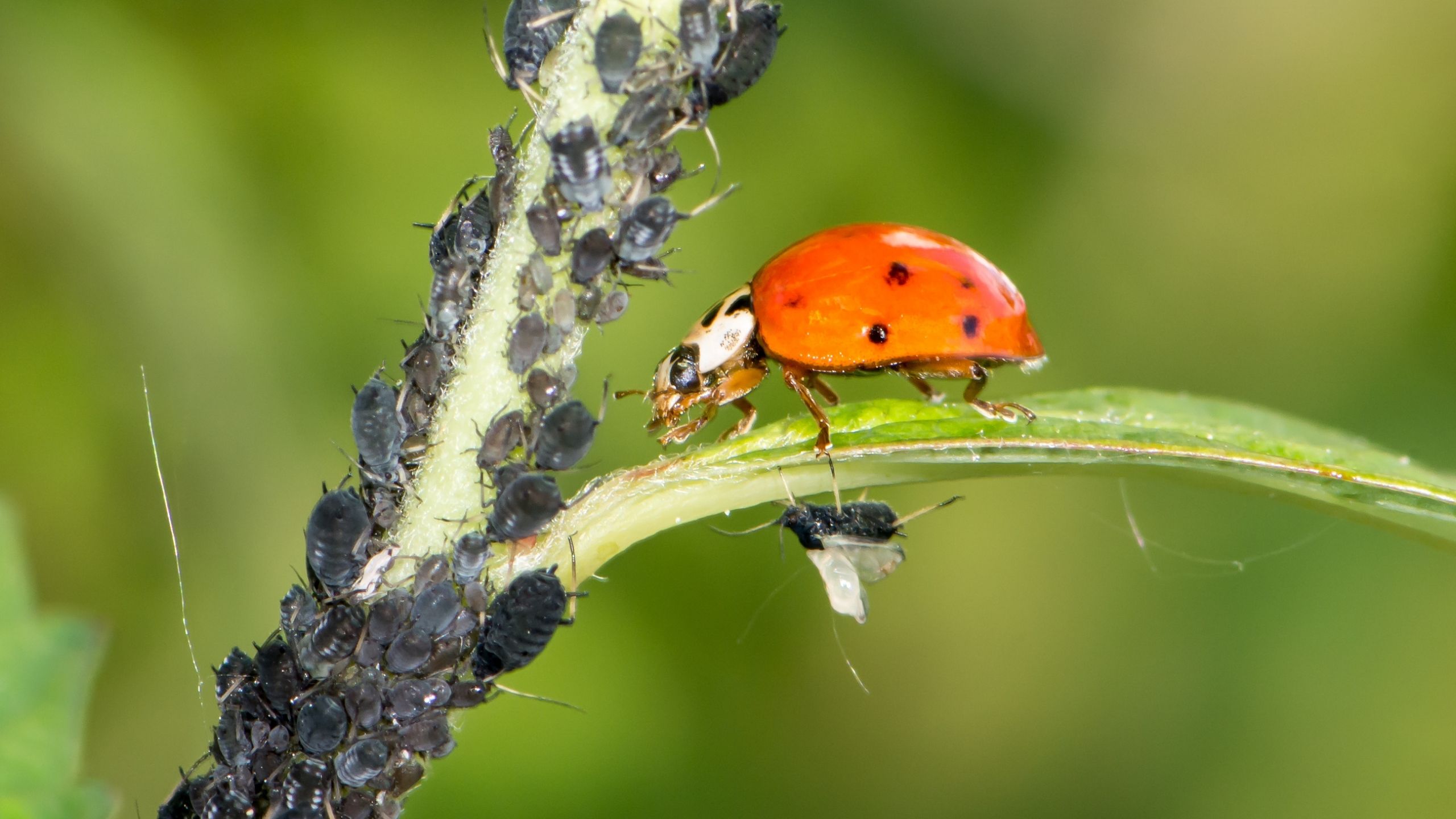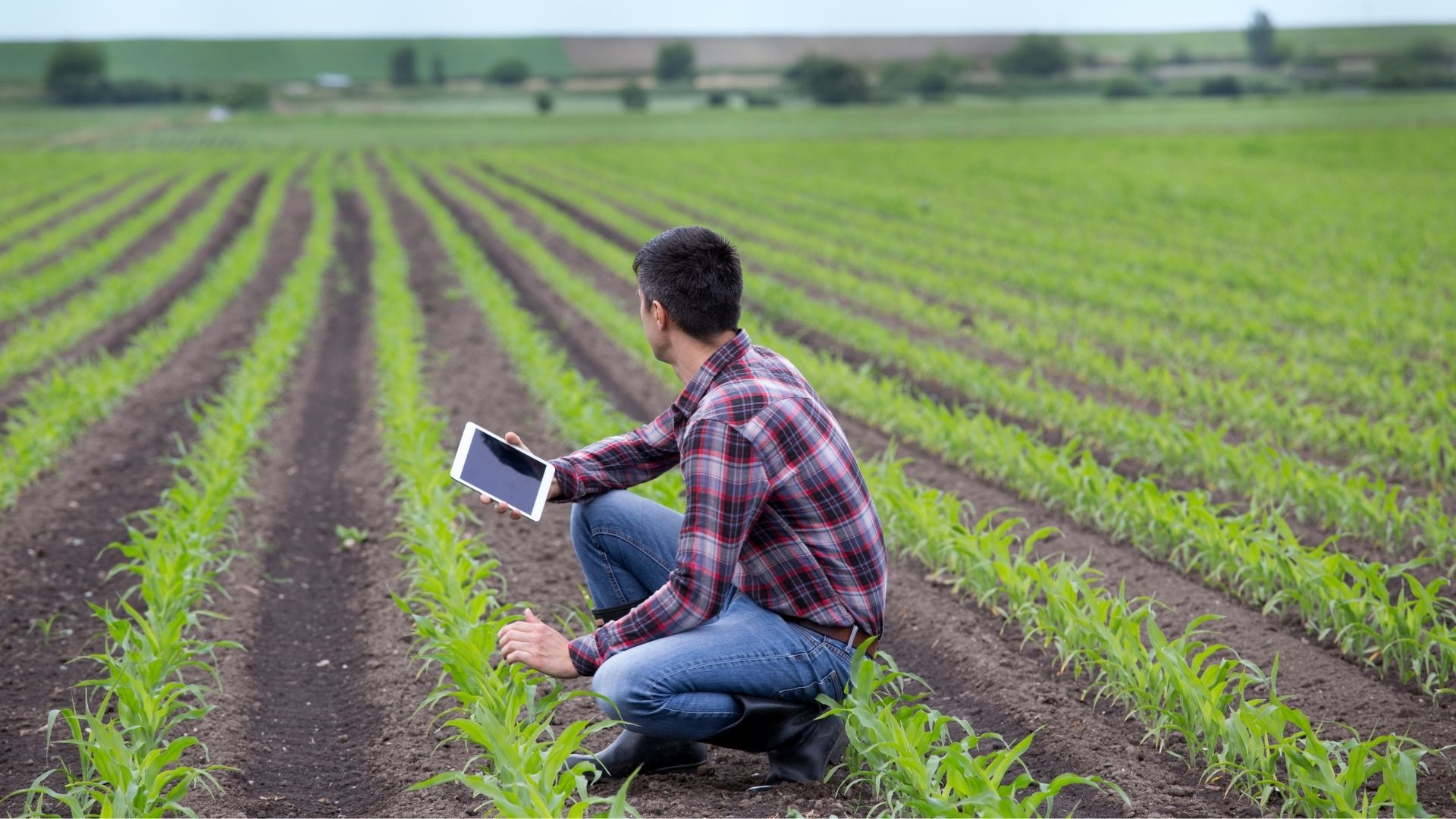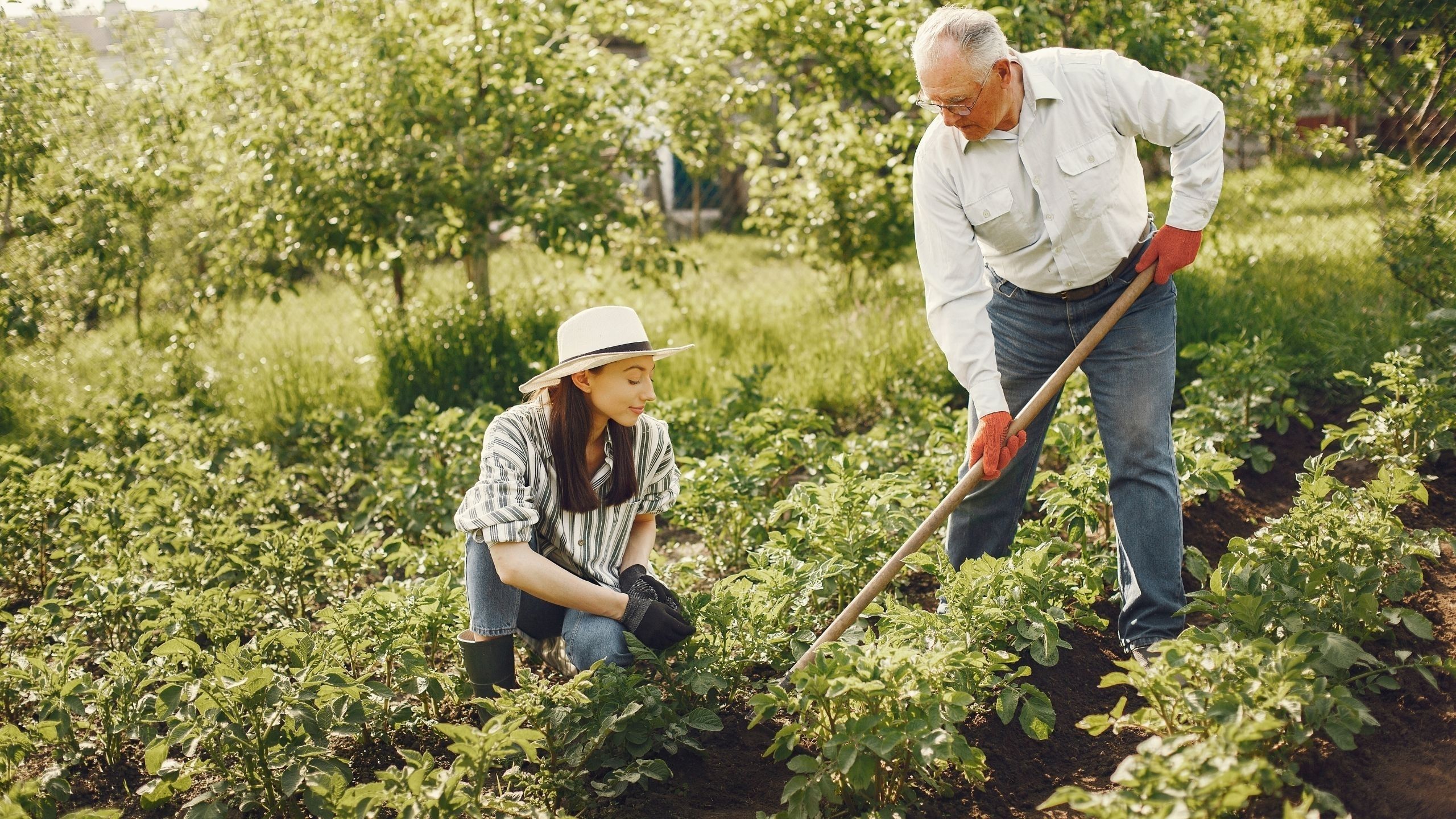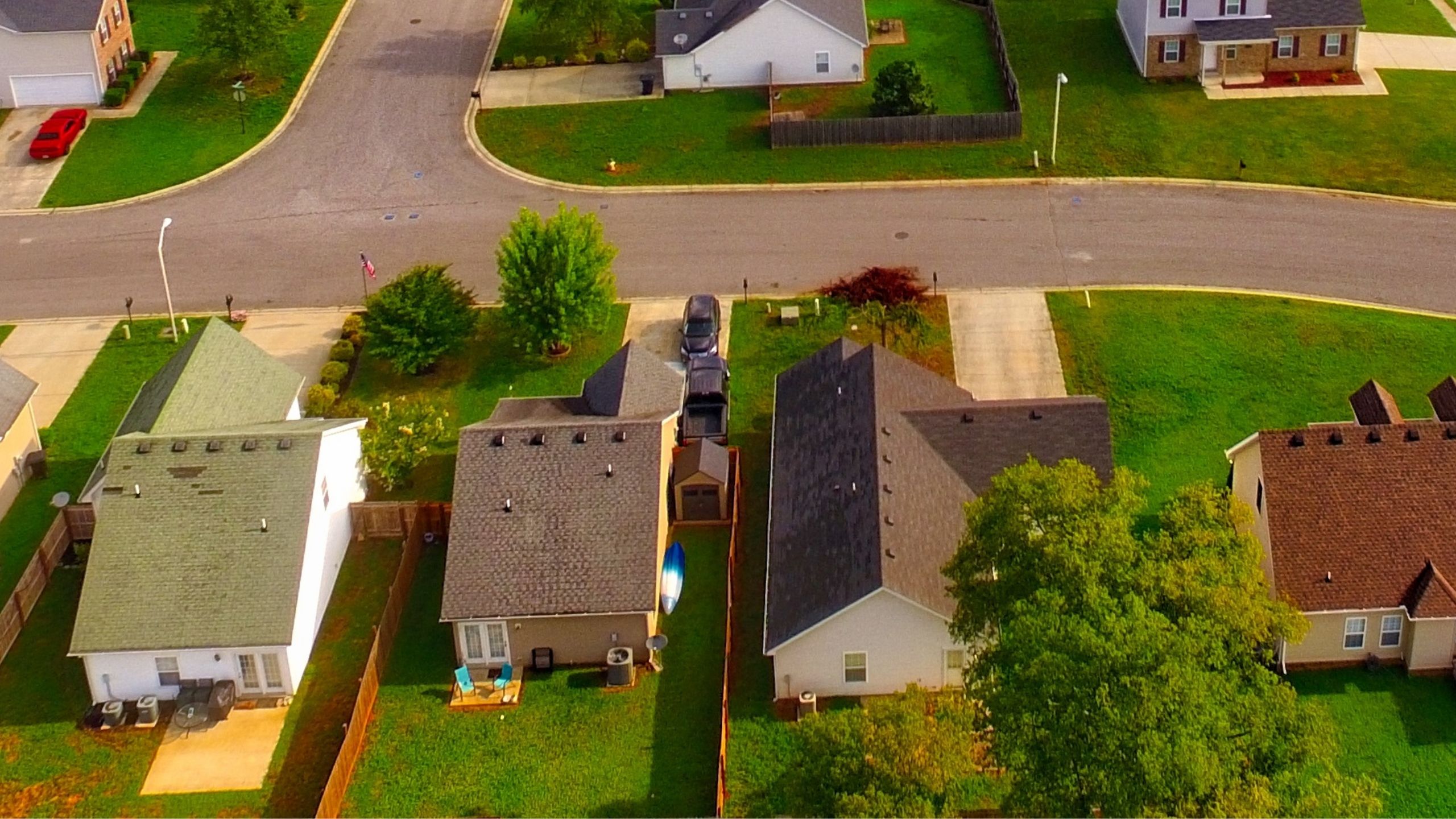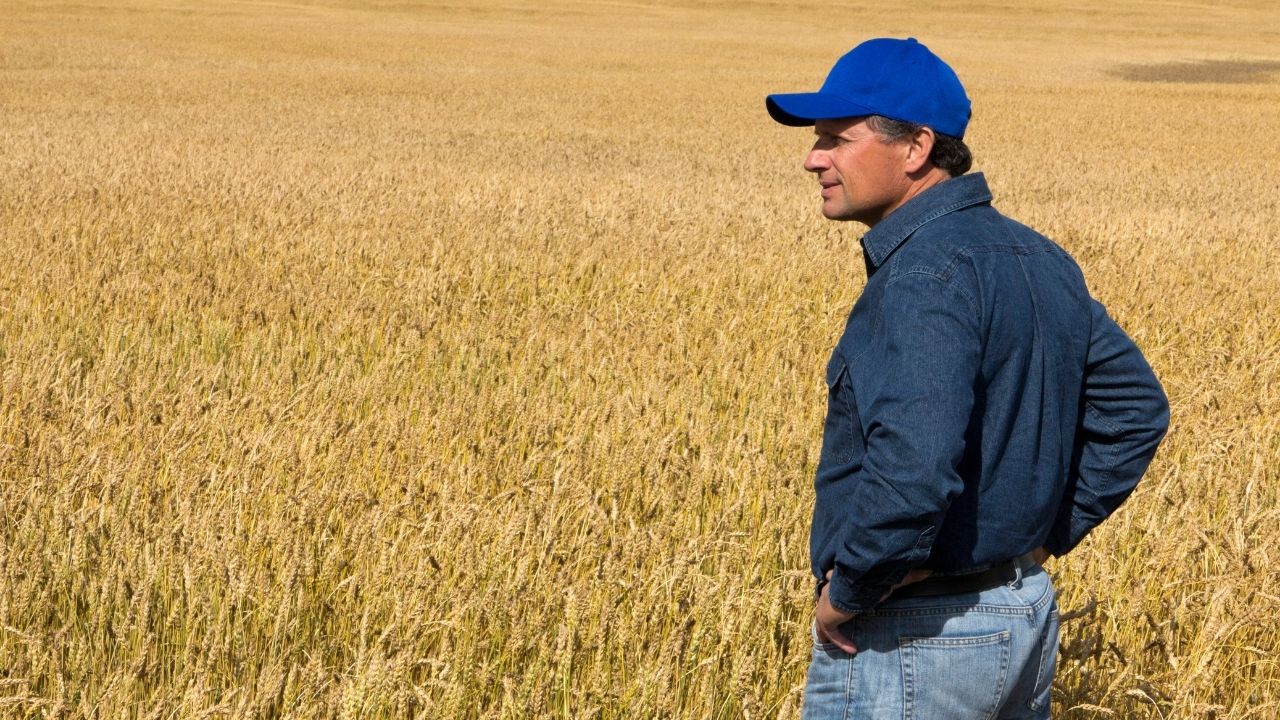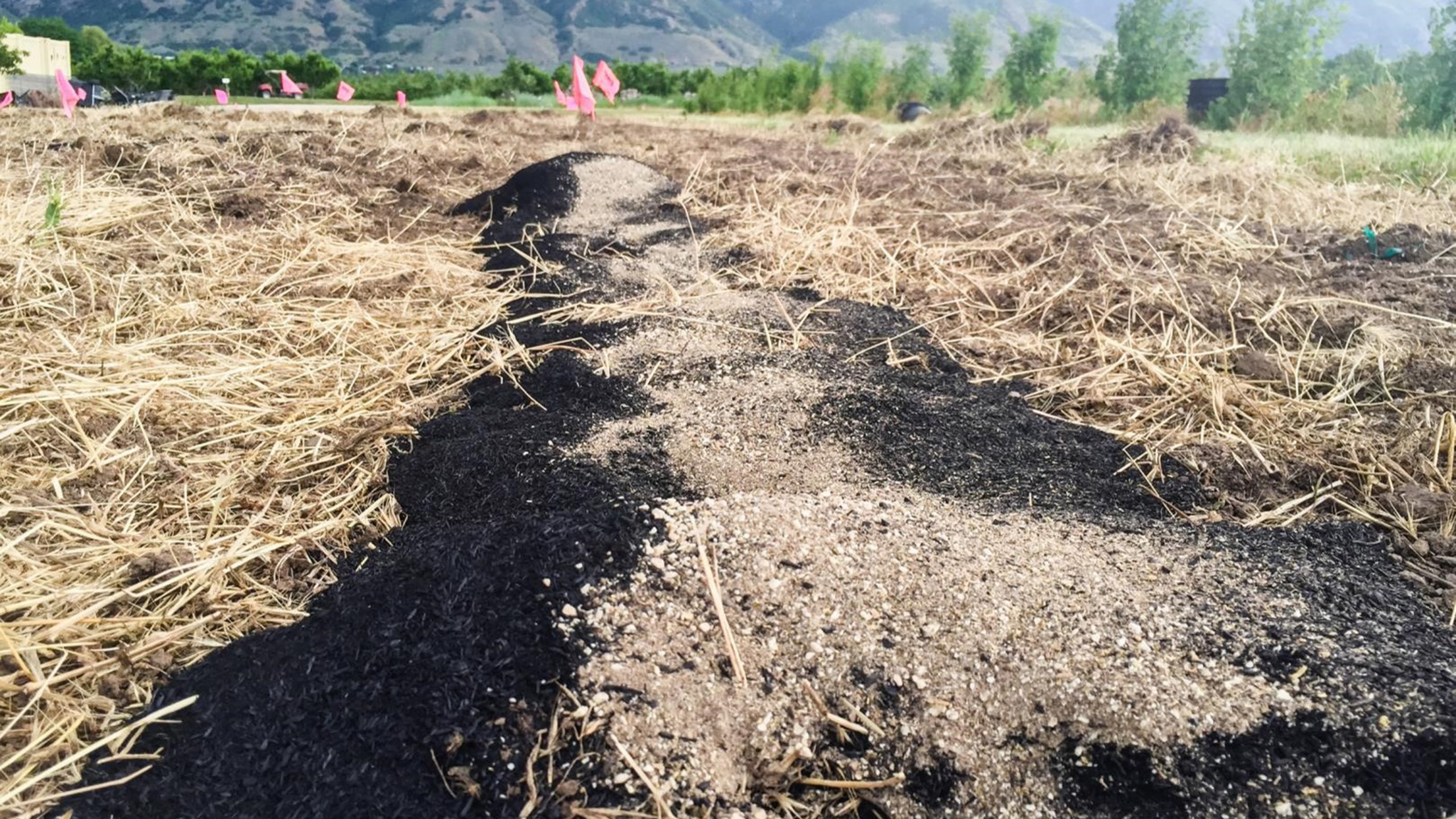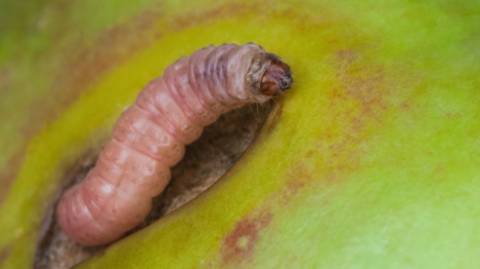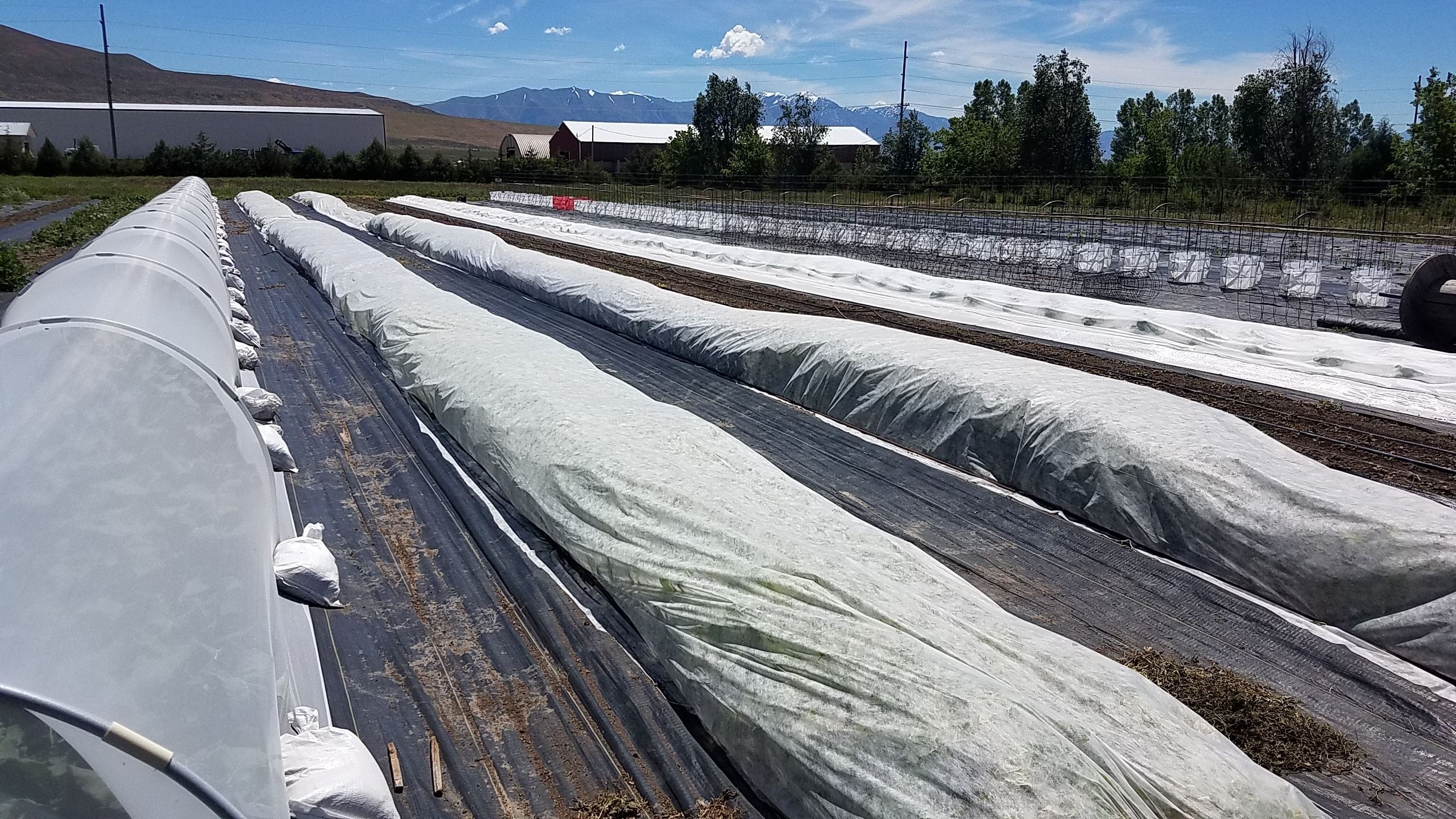Integrated Pest and Pollinator Management
August 2022
Ann Mull, Extension Assistant (No longer at USU) • Lori R Spears, CAPS Coordinator (No longer at USU) • Marion Murray, IPM Project Leader • Ricardo Ramirez, Extension Entomologist (No longer at USU)
Quick Facts

- The decline in pollinator species and abundance warrants
that pest management activities consider pollinator
health. - Integrated pest and pollinator management (IPPM)
seeks to balance the management of pests (insect,
weed, disease) alongside beneficial species (pollinators,
predators, parasitoids, entomopathogens). - IPPM focuses on promoting diversity by incorporating
pest-resistant and pollinator-attractive cultivars and
pollinator-friendly pest management techniques. - IPPM is for all plant growers, from patio and backyard
gardeners to small and large agricultural and horticultural
producers. - IPPM can help increase crop pollination, reduce pesticide
usage, and decrease economic costs.
Introduction
An inextricable link exists between humans and pollinators, with benefits that include ecosystem health and function and human food security. Bees, butterflies, moths, wasps, flies, and beetles are responsible for most of the world’s pollination services. An added benefit is that many of these species are important natural enemies (predators, parasitoids, and entomopathogens) that provide natural pest suppression (biocontrol) of pest insects and mites. Considering the mounting scientific evidence denoting global pollinator declines, there is a critical need to prioritize pollinators and the essential services they provide.
Integrated pest management (IPM) is widely used to manage pests (insects, mites, weeds, and diseases). IPM helps reduce pesticide use while maintaining effective pest control, but it has been criticized for being “pest centric” (Deguine et al., 2021) and not explicitly “pollinator-friendly” (Egan et al., 2020). Integrated pest and pollinator management (IPPM) (Fig. 1) is a new framework that combines IPM methods with tactics that prioritize beneficial species (Biddinger & Rajotte, 2015; Egan et al., 2020) for a more conservation-forward approach.
The IPPM pyramid (Biddinger & Rajotte, 2015; Egan et al., 2020) (Fig. 1) contains four steps to be implemented sequentially, beginning at the base and working upward as further pest management needs arise. Like IPM, IPPM prioritizes proactive preventive measures over reactive pesticides, and uses decision support tools that include degree-day models, action thresholds, and joint economic impact levels (Alston, 2011; Flöhr et al., 2020; Murray, 2020) (See Table 1 for definitions). Before beginning any pest management program, it is imperitive to correctly identify the pest and understand its biology and life cycle. Knowing the types of beneficial species that visit or pollinate the crop is also useful information. Several resources are available for insect identification, including the Utah Plant Pest Diagnostic Lab (UPPDL).
Table 1. Decision Support Tools to Enhance IPPM Results
| Decision support tool | What is it? |
|---|---|
| Degree days | Degree days (DD) are used to predict an insect’s rate of development. DD measures heat units over time using daily maximum and minimum temperatures in a given location |
| Action threshold | The pest density when control measures should be implemented to prevent reaching the economic injury level. |
| Economic injury level | A pest’s lowest population level that will cause economic damage; the amount of injury that justifies the control costs. |
| Joint economic impact level | Integrates economic injury levels with a pollinator equivalent. This joint metric is then used to perform a cost-benefit analysis of pest and pollinator management. |
Step One
Agroecosystem Diversity and Habitat Modification
Diversifying gardens and agricultural fields and protecting or restoring natural habitats can provide sufficient resources for pollinators and natural enemies. High plant diversity and irregularly shaped areas of natural and semi-natural habitat attract and sustain beneficial insects (Egan et al., 2020; Lundin et al., 2021). Plants that can help attract pollinators and natural enemies are shown in Table 2. Note that natural enemies prefer plants with small flowers. Choose plants that target pollinators of your crop, are adapted to local conditions, and that have similar or slightly earlier bloom times as the main crop. Also, ensure the plants are maintained to eliminate spread (Egan et al., 2020). Mixtures of flowering plants attract more beneficial insects than a single plant and can be used to extend the bloom period (Sustainable Agriculture Research and Education [SARE], 2015). When choosing plant mixtures, select a minimum of one plant species per bloom period (early, mid, and late). An ideal mix contains three species per bloom period (Natural Resources Conservation Service [NRCS], 2019).
Table 2. Pollinator- and Natural Enemy-Attractive Plants for Crop and Landscape Use
| Decision support tool | What is it? |
|---|---|
| Row crops (herbaceous perennials) |
asters*, flax*, yarrow*, goldenrod*, coreopsis*, penstemon*, wild onion*, Cleome spp.*, sweet vetch*, prairie clover, globemallow*, arrowleaf balsamroot*, mules ear*, Monarda spp.*, milkweed* |
| Cover crops (annuals and perennials) |
alfalfa, white clover, red clover, cowpea, lupine*, partridge pea, sunn hemp, hairy vetch, turnip, fava bean, phacelia*, canola, sunflower*, forage radish, daikon radish, buckwheat, rye, oat, soybean, Sudangrass, millet, teff, other brassicas* and mustards* |
| Border plants (woody perennials) |
ninebark*, cliff rose*, elderberry* |
* Utah native species options exist
Sources: Cane & Kervin, 2013; SARE, 2015; NRCS, 2019; Rowe et al. 2021
Pest-Resistant and Pollinator-Attractive Crop Cultivars
Select pest-resistant crop cultivars that are also attractive to pollinators and natural enemies when available. Resistant plants disrupt the normal association between pest and host by affecting a pest’s biology (antibiosis) or behavior (antixenosis), or a plant’s ability to withstand or recover from damage (tolerance). Pest resistant cultivars, such as Enterprise apple (resistant to fire blight) or Mahaleb cherry rootstock (resistant to bacterial canker), may lessen crop deficits and lead to increased profit (Wiseman, 1994; Muola et al., 2017).
Many variations of pollinator-friendly labels can be found, including “bee friendly,” “good for pollinators,” and “butterfly attractive.” However, natural enemy friendly labels are generally not used. If in doubt and if possible, monitor plants over a 10-minute period to get a broad estimate of their attractiveness to beneficial species (Erickson et al., 2022).
Step Two
Pollinator-Friendly Cultural, Physical, and Mechanical Control
Other means of enhancing pollinator habitat include companion crops (intercropping), cover crops, crop rotation, tillage, and careful irrigation, fertilization, and pest control.
Companion crops involve planting a crop-within-a-crop and result in the highest benefits for both pollination and biocontrol. Companion crop practices vary but commonly include using trap crops and susceptible cultivars to divert damage from pest feeding and egg-laying. Companion crops should be robust enough to benefit both pollinators and natural enemies and to allow pollination services to overflow into the main crop.
Cover crop options include multipurpose, pollinator-attractive plants (see Table 2), and should be sown by seed so the bloom period synchronizes with peak pollinator availability (Egan et al., 2020).
Crop rotation and tillage may disrupt some predators and pollinators, so incorporating no-till soil practices can promote beneficials that include many species of ground-nesting bees that rely on bare soil and fallow areas and natural enemies that complete their life cycles in the soil. Consider a perennial crop rotation using clover or alfalfa, which allows soil nitrogen to be naturally replaced with less soil disruption.
Adequate soil moisture can increase nectar production and crop pollinator visitation. When using overhead sprinkler systems, irrigate between dusk and dawn when most pollinators are inactive, and when possible, avoid flood irrigation, which can especially disturb predators and native ground-nesting bees.
Organic fertilizers provide slow release of valuable nutrients while also improving the soil’s physical properties. Crops grown organically have been shown to enhance predator visits while also significantly increasing the density of solitary bees and bumble bees (Lichtenberg et al., 2017).
Pest control should focus on non chemical options such as preventing weeds with mulches or excluding insect pests with netting or row covers (Volesky & Wagner, 2020). Note that row covers must be removed at critical times to allow pollinator access. Insect traps can also be used to monitor for insect pests, but avoid using white-colored traps, as white has been shown to attract and capture pollinators (Spears et al., 2021).
Step Three
Managed Pollinators and Biocontrol Agents
A successful IPPM plan avoids the need to add managed pollinators and biocontrol agents. Managed pollinators include the honey bee (Apis melifera) and alfalfa leafcutting bee (Megachile rotundata) or native bees such as the alkali bee (Nomia melanderi) and blue orchard bee (Osmia lignaria) (Isaacs et al., 2017). A wide range of biocontrol agents are available for many pests, but most are best used in protective agriculture, such as high tunnels or greenhouses, where they will stay at the crop. Examples include lacewings, lady beetles, minute pirate bugs, and parasitoid wasps and flies. Further, predatory spider mites can be successfully released outdoors to control spider mite pests. Timing of the release is critical, however, as most agents require additional time to affect the pest population, and many only attack certain life stages of the pest (AgriLife.org).
Step Four

Notes. Bee activity occurs beyond the months listed in this table. Prime
activity in southern Utah extends on both ends by a month or more. Image courtesy of Wilson & Messinger Carril (2016) and Zesiger et al, (2021).

Pesticides
When chemical pest control is warranted, give preference to reduced-risk pesticides, such as biological pesticides (see below). Do not apply any pesticides when bees are actively foraging (Fig. 2), when conditions may cause drift, or when plants are in bloom (flowering), shedding pollen, or producing nectar. In general, late evening applications are preferable, as some common native bee pollinators are active at dawn. Take care to only apply pesticides in areas within the crop where pest activity exceeds the activity of natural enemies (May et al., 2015). Note that it is a violation of federal law to use a pesticide in a way that differs from the product labeling.
Biological pesticides (biopesticides) are derived from natural sources such as animals, plants, bacteria, and minerals and are generally considered safer for humans, beneficial species, and the environment. Depending on the product, they work in a variety of ways including killing insect pests via contact or by ingestion, preventing fungal spore germination, repelling insects, disrupting mating, and more. Read product labels carefully and use these products with caution, as some may still pose risks, including plant phytotoxicity.
Conventional pesticides (insecticides, herbicides, miticides, and fungicides) should only be used after all previous IPPM pyramid steps have been incorporated. Although pesticides vary in their toxicity, many of them are harmful to bees and other beneficial species when not used as directed. Some products that are toxic to bees contain a bee advisory box label (Fig. 3). Although label appearances can vary, look for a bee image in a diamond shape or a label statement such as, “This active ingredient is toxic to bees.” Note that neonicotinoid products are prohibited where bees and flowers are present.
References And Further Reading
- AgriLife Extension. (n.d.). Landscape IPM: Types of biological control. Texas A & M University.
- Alston, D. G. (2011). Pest management decision-making: The economic-injury level concept [Fact sheet IPM-016-11]. Utah State University Extension.
- Biddinger, D. J., & Rajotte, E. G. (2015). Integrated pest and pollinator management—adding a new dimension to an accepted paradigm. Current Opinion in Insect Science 10, 204-209.
- Cane, J., & Kervin, L. (2013). Gardening for native bees in Utah and beyond [Fact sheet ENT-133-09]. Utah State University Extension.
- Deguine, J. P., Aubertot, J. N., Flor, R. J., Lescourret, F., Wyckhuys, K. A. G., & Ratnadass, A. (2021). Integrated pest management: Good intentions, hard realities. A review. Agronomy for Sustainable Development 41, 38.
- Douglas, M. R., Sponsler, D. B., Lonsdorf, E. V., & Gronzinger, C. M. (2020). County-level analysis reveals a rapidly shifting landscape of insecticide hazard to honey bees (Apis mellifera) on U.S. farmland. Scientific Reports 10, 797.
- Egan, P. A., Dicks, L. V., Hokkanen, H. M. T., & Stenberg, J. A. (2020). Delivering integrated pest and pollinator management (IPPM). Trends in Plant Science 25, 577-589.
- Erickson, E., Grozinger, C. M., & Patch, H. M. (2022). Measuring plant attractiveness to pollinators: methods and considerations. Journal of Economic Entomology, toac066.
- Fenster, C. B., Armbruster, W. S., Wilson, P., Dudash, M. R., & Thomson, J. D. (2004). Pollination syndromes and floral specialization. Annual Review of Ecology, Evolution, and Systematics 35, 375-403.
- Flör, A., Stenberg, J. A., & Egan, P. A. (2020). The joint economic impact level (jEIL): A decision metric for integrated pest and pollinator management. In Gao, Y., Hokkanen, H., & MenzlerHokkanen, I. (Eds.), Integrative Biological Control 20. Springer.
- Isaacs, R., Williams, N., Ellis, J., Pitts-Singer, T. L., Bommarco, R., & Vaughan, M. (2017). Integrated crop pollination: Combining strategies to ensure stable and sustainable yields of pollinationdependent crops. Basic and Applied Ecology 22, 44-60.
- Lamke, K., & Hatfield, R. (2020). Five ways to support queen bumble bees this spring. Xerces Society for Invertebrate Conservation.
- Lichtenberg, E., Kennedy, C., Kremen, C., Batary, P., Berendse, F., Bommarco, R., Bosque-Perez, N., Carvalheiro, L., Snyder, W., Williams, N., Winfree, R., Klatt, B., Astrom, S., Benjamin, F., Brittain, C., ChaplinKramer, R., Clough, Y., Danforth, B., Diekotter, T.,...Crowder, D. (2017). A global synthesis of the effects of diversified farming systems on arthropod diversity within fields and across agricultural landscapes. Global Change Biology 23, 4946-4957.
- Lundin, O., Rundlöf, M., Jonsson, M., Bommarco, R., & Williams, N. M. (2021). Integrated pest and pollinator management—expanding the concept. Frontiers in Ecology and the Environment 19, 283-291.
- May, E., Wilson, J., & Isaacs, R. (2015). Minimizing pesticide risk to bees in fruit crops [Bulletin E3245]. Michigan State University Extension.
- Muola, A., Weber, D., Malm, L. E., Egan, P. A., Glinwood, R., Parachnowitsch, A. L., & Stenberg, J. A. (2017). Direct and pollinatormediated effects of herbivory on strawberry and the potential for improved resistance. Frontiers in Plant Science 8, 823. doi: 10.3389/ fpls.2017.00823
- Murray, M. (2020). Using degree days to time treatments for insect pests [Fact sheet IPM-05-08]. Utah State University Extension. Natural Resources Conservation Service [NRCS]. (2019). Plants for pollinators in the Intermountain West [Plant Materials Technical Note No. 2A]. U.S. Department of Agriculture.
- Rowe, L., Gibson, D., Landis, D. A., & Isaacs, R. (2021). Wild bees and natural enemies prefer similar flower species and respond to similar plant traits. Basic and Applied Ecology 56, 259-269.
- Spears, L. R., Christman, M. E., Koch, J. B. U., Looney, C., & Ramirez, R. (2021). A review of bee captures in pest monitoring traps and future directions for research and collaboration. Journal of Integrated Pest Management 12, 49. Sustainable Agriculture Research and Education [SARE]. (2015). Cover cropping for pollinators and beneficial insects. SARE Outreach.
- Volesky, N. & Wagner, K. (2020). Row covers [Fact sheet IPM-020-20- PR]. Utah State University Extension. Wilson, J. S. & Messinger Carril, O. J. (2016). The bees in your backyard—A guide to North America’s bees. Princeton University Press, Princeton, New Jersey.
- Wiseman, B. R. (1994). Plant resistance to insects in integrated pest management. Plant Disease 78, 927-932.
- Zesiger, C., E. Cohen, E., Jarvis, H., Spears, L., & Ramirez, R. (2021). Beginner’s guide to common native bees [Fact sheet ENT-231-21- PR]. Utah State University Extension.


